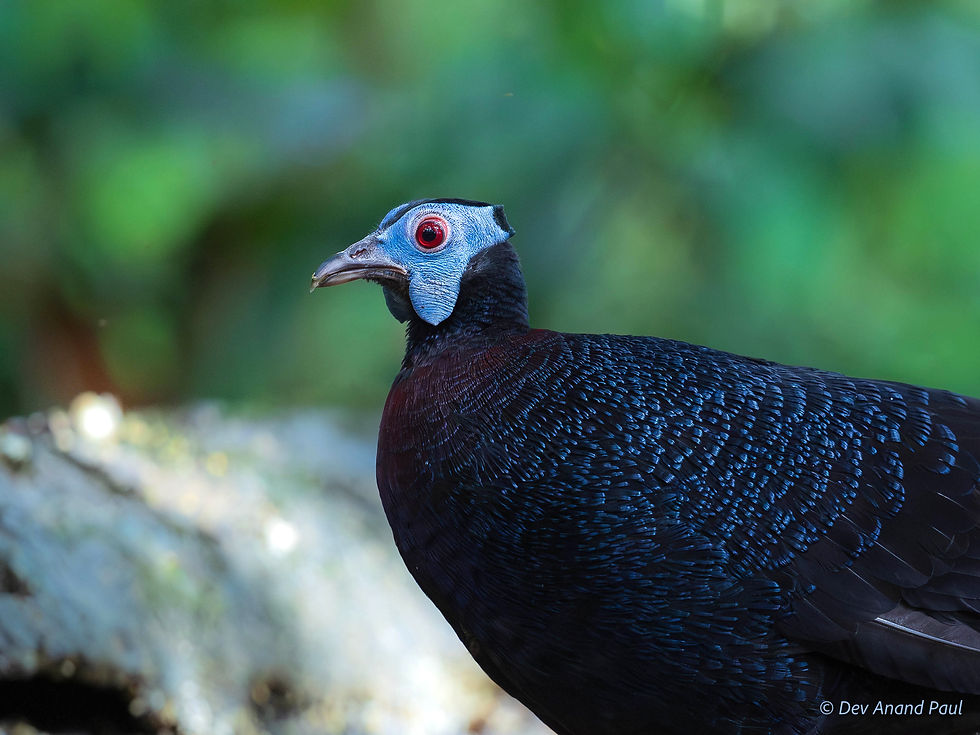Birding in Borneo: Crested Fireback and Bulwer’s Pheasant
- devanandpaul
- Sep 28
- 4 min read

Borneo’s rainforests are among the oldest on earth, dating back over 130 million years. Vast, humid, and teeming with life, they are divided between Malaysia, Indonesia, and Brunei, sheltering orangutans, pygmy elephants, hornbills, countless insects, and rare plants. Dipterocarps (tall hardwood tropical trees) tower like cathedrals, rivers snake through dense undergrowth, and the air feels alive with calls, buzzes, and whispers of the wild.

Home to Rare and Secretive Birds
Beneath the dipterocarps, on the forest floor, live two of the island’s most secretive birds: the Bornean crested fireback (Lophura ignita) and Bulwer’s pheasant (Lophura bulweri). Endemic to Borneo, both these pheasants are rarely spotted in the wild, making them a top priority in Borneo birdwatching tours.
Here I share their story, blending natural history, local community involvement, and my own encounters with these birds, not to mention the urgent call for their conservation.
A Tale of Two Pheasants
The Bornean crested fireback is, as its name suggests, a burst of fire in the shadows. The male dazzles with shimmering blues and purples, and golden-orange tail feathers that fan out like tongues of flame. Add to that a tufted crest and an electric blue facial skin, and you have a bird that looks dressed for royalty. It dances energetically with wing flaps and fiery tail displays. The female, by contrast, in earthy browns and russets, seamlessly blends with the forest floor, where she nests.


Although the bird is wary and quick to vanish, with patience and luck, you can still encounter it, as it forages on the forest floor for fruits, seeds, and insects.
The Bulwer’s pheasant (also known as the white-tailed wattled pheasant), however, is a phantom of Borneo. It moves quietly through the rainforest, seldom seen even by the most seasoned birders.


Males are breathtaking—gleaming black plumage, a sweeping white tail like a flowing banner, and sky-blue facial skin that extends into wattles and glows like a mask in the shadows. Females, again, in subtle browns, blend with the undergrowth.
Unlike the fireback, much of what we know about the courtship of this pheasant comes from captivity—tail fanning, feathers puffing, and the blue wattles erecting in a silent dance of allure.
Both species are threatened by deforestation, palm oil plantations, and hunting. Population estimates suggest steep declines, and scientists warn that continued habitat loss may push them towards endangerment. Listed as Vulnerable by the IUCN, these birds must be protected to maintain Borneo’s rainforest biodiversity.
For birders, these pheasants are among the holy grails of the island’s avian world.

My Encounter with the Pheasants
Despite these pheasants being elusive, I was lucky to observe them closely, and even managed to take detailed photographs, something I had thought impossible.
The secret? Bird hides.
Why Hides Matter
Forest trekking is thrilling—walking under towering trees, catching flashes of movement, never knowing what lies ahead. But motion often drives wildlife away. And a hide is a game changer. Sit still and wait, and the forest forgets your presence. Birds step into view, forage without caution, preen leisurely, and behave as though the world belongs entirely to them.

For photographers, hides provide enough time to capture every behaviour, every nuance. Yet there is no guarantee that these birds will appear. Luck still plays a role, but the hides shift the odds in your favour.
A Conversation About Hides
As we walked back to the road after the hide session, I turned to my guide, Arka Sarkar.
‘Arka,’ I whispered, ‘how did birders manage to spot these birds before these hides, as seeing these two pheasants in the wild is nearly impossible?’
He smiled knowingly. ‘That’s exactly the point. Before 2021, hides like these didn’t exist. Birders relied entirely on chance. Weeks of trekking, and many returned without a single glimpse. It was luck, patience, and heartbreak, all in one.’
I pictured it: birdwatchers travelling halfway across the world, navigating muddy trails, and leaving empty-handed.
‘But after 2021,’ Arka continued, ‘local communities began observing the birds’ patterns—where the fireback forages, where the Bulwer’s steps cautiously into light—and built hides. Wooden shelters with narrow viewing windows transformed the odds. Today, if you sit patiently, it’s almost certain these birds will appear.’
I recalled the morning hush inside the hide and the thrill when the fireback stepped into the clearing, as if called by magic.

‘Of course,’ Arka added with a wry smile, ‘this certainty comes at a cost. Hides are priced from 400 to 900 ringgit per person per day. For some, that’s steep. Yet, almost every day they’re fully booked. Birders, photographers, researchers—everyone is willing to pay because this is the only way to see these rare treasures.’ Part of the fees supports local communities, providing them enough incentive to protect the birds and their habitats rather than hunt them. Thus, hides are more than birding tools—they are instrumental in wildlife conservation.

His words lingered. The hides have revolutionized birding in Borneo, making sightings more reliable, also more exclusive. But the magic moments with these pheasants make the cost worthwhile.
Closing Reflections
Jane Goodall, a world-renowned British primatologist, once said: ‘What you do makes a difference, and you have to decide what kind of difference you want to make.’
Where once unchecked hunting had silenced the calls of the Bornean crested pheasant and Bulwer’s pheasant, today local communities are their protectors—their hides invite wildlife enthusiasts to witness these pheasants in their natural home. So there is hope. If you are drawn to Borneo birding tours, rare Southeast Asian pheasants, or wildlife photography in Borneo, these hides offer unforgettable encounters while directly supporting conservation and sustainable livelihoods.
By protecting these pheasants, we ensure the songs of the rainforests stay alive for generations to come.

Related posts:




Excellent. Great to see these birds.